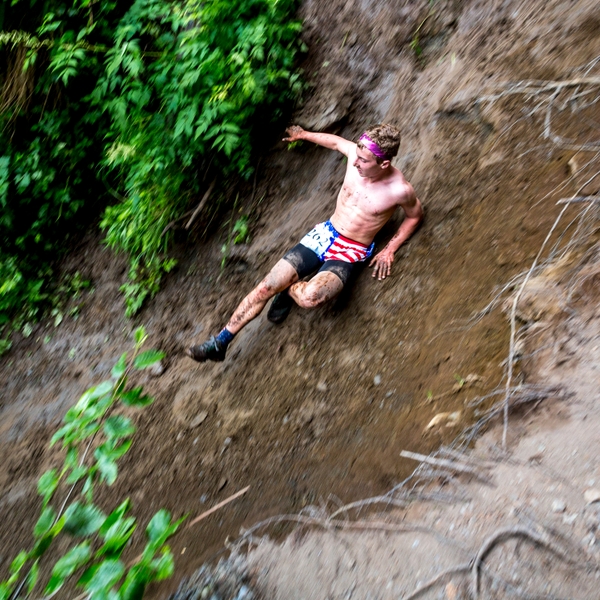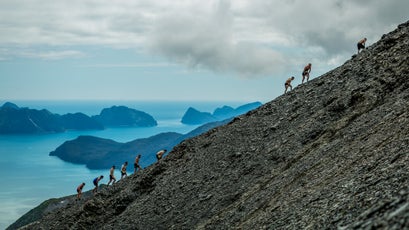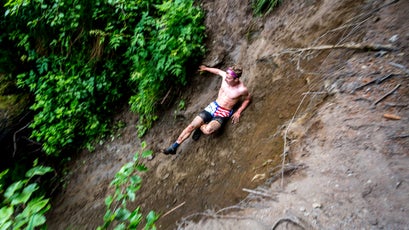Mount Marathon Is the Toughest 5K on the Planet
Every July Fourth, hundreds of racers descend on Seward, Alaska, for one of the most difficult short-distance races on the planet—3,000 feet up, and then straight back down Mount Marathon
Heading out the door? Read this article on the Outside app available now on iOS devices for members! Download the app.
The lights in the Seward High School gymnasium were dimmed so that the dozens of people scattered across the bleachers and the shining hardwood floor could clearly see the images being projected on a large screen. There was a short video clip of a man clinging to a steep wall of earth and tree roots—until a loose rock the size of a bowling ball tumbled down and knocked him loose. There was a still photograph of a woman in mid-freefall, limbs splayed, the rocky cliff face a gray blur behind her. A narrated voiceover accompanied the images, reeling off the “countless opportunities” for injury: “snow fields, devil’s club, loose shale…”
The man working the laptop connected to the projector chimed in. “You signed a form that said you’ve been up the mountain,” he said. “We want to make sure you’ve been up the mountain.” He paused so his serious tone could sink in. “This isn’t any old 5K.”
That was an understatement. The Mount Marathon Race, held every year in Seward, Alaska, might be the world’s gnarliest three-miler. Calling it a running event is barely accurate: It’s more of a high-speed scramble directly up its eponymous mountain, and then back down again. The fastest racers aim to finish in under an hour; even the best mountain runners in the world can’t crack 40 minutes.
The images were being shown as part of a safety meeting—mandatory for rookie racers—that takes place the night before the race. There are three ways for hungry newcomers to get one of the approximately 700 race bibs—350 each for men and women. First, they can enter the main lottery, held in April. Failing that, here in the high school, the night before the race, they can buy as many $10 raffle tickets as they can afford in hopes of landing the single bib given away in a draw. If that doesn’t work out, they’re left with the auction: ten men’s bibs and ten women’s bibs given out to the highest bidder. This year, the bidding went as high as $3,500. (The money goes to the Seward Chamber of Commerce to pay for the costs associated with organizing the race.)
Patrick Stinson, a 37-year-old grad student who’d run the race seven times before, missed a year in 2016 and wound up paying $3,000 in the auction to buy his way back in. (Ten-time finishers get lifelong tenure, as do champions.) “It’s totally unique in Alaska,” he said. “It’s technically so hard.” Tommy Nenahlo, 31 and about to become a dad, also paid $3,000 for his bib—a pre-baby gift from his wife after six years of failed lottery entries. “There’s nothing like being able to compete at such a level in a place like this,” he said.
I know what you’re thinking: Three grand to run a 5K? But Mount Marathon, iconic and brutal and more than a century old, has that kind of effect on people.
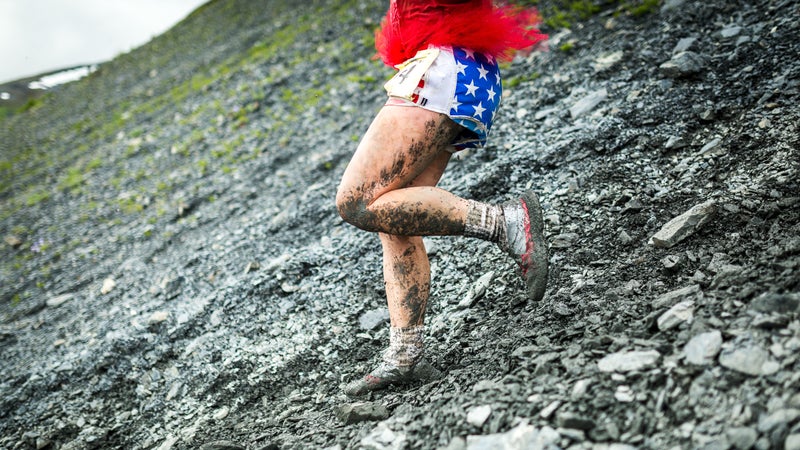
The next morning was the Fourth of July—Mount Marathon is always held on the Fourth—and the barricades along Seward’s main drag were lined with starred-and-striped spectators. On the cross streets, vendors hawked hot dogs and Kettle Korn, Hawaiian iced sodas and Dippin’ Dots, fried halibut chunks and grilled corn. There were booths selling hoodies (“Mountain Mama”) and bumper stickers (“Hiked It. Liked It.”) and Top 40 tunes blasting from a massive PA system. At one intersection, the Seward Fire Department had hung a massive American flag from the ladder of one of its parked trucks, extending it high above the street.
At 11 a.m., nearly 350 women gathered behind the start line. The junior race, for runners ages 7 to 17, had already taken place—the kids went only halfway up the broad, triangular mountain that looms over downtown Seward. The men would take their turn after the women, tackling the full-length course at 2 p.m. This year, the outcome of the men’s race seemed nearly certain: a cross-country skier, Scott Patterson, was heavily favored to win. But the outcome of the women’s race was harder to call.
The race began at 4th Avenue and Adams Street, just two blocks above the cold, dark waters of Resurrection Bay. Seward sits at the head of the long, narrow bay, on the east side of the Kenai Peninsula, and, on a clear day, the water and the glacier-draped mountains that hem it in stretch as far as you can see. But no one was looking at the view right now. The runners had their backs to the ocean, and their focus was on the street that sloped upward ahead of them, leading to the base of Mount Marathon.
Toeing the line was Christy Marvin, the defending women’s champion; immediately to her left was Allie Ostrander, a six-time junior champion whose 2014 time of 28:54 was still a girls’ course record. In 2015, at 18, Ostrander finished second in her first senior race. A promising runner for Boise State, she skipped Mount Marathon last year to focus on the Team USA Olympic trials, and now she was back on the mountain where she’d grown up running. Wearing festive red shorts and a blue sports bra, Ostrander looked tiny and baby-faced next to the older, taller, and more visibly muscular runners waiting for the starting pistol to go off. But by the time they’d covered the half-mile of pavement that led to the base of the mountain, Ostrander had a clear lead.
When she reached the base, Ostrander and all the runners following her had a series of choices to make. Mount Marathon has no fixed course: The rules simply require that runners begin at the start line, circle around a large boulder at the false summit that marks the turnaround point, and end at the finish line. In between, the mountain offers several options of varying efficiency and potential danger. The line each runner selects as they ascend and descend the mountain is up to them.
The first choice: Go right and climb the roots, or go left and ascend the cliff. The start of the trail up Mount Marathon feels nearly vertical, but to the right, a jungle gym of tree roots offers easy climbing; to the left, there’s a rocky scramble, potentially faster but tougher. Then the trails converge again, winding steeply up through dense, damp forest and—after a few days of rain—greasy, slick mud. Runners propel themselves upward with hands as much as feet, pulling on exposed tree roots as thin as shoelaces and digging their fingers into the soil.
The foliage thins out to nothing as the runners hit the halfway point to the false summit, where the juniors turn around to descend and the seniors carry on through a steep, open field of broken shale. From here, it’s a pure grind to the top. The trail has an average grade of 34 degrees—at its steepest, it hits 60 degrees. Racers pump uphill with their hands on their quads, pushing down on their legs with each step, bending over at the waist but trying to keep their back straight and their airway open. They gain 3,000 feet of elevation in under a mile.
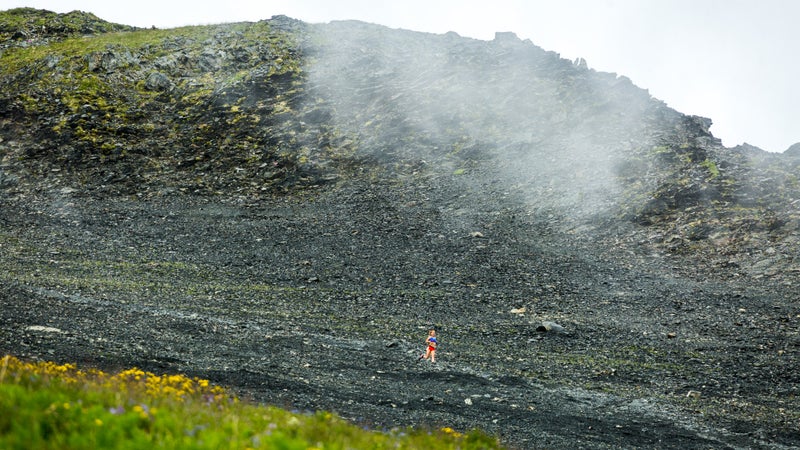
Ostrander opted to go right, to the roots, while the two women behind her, defending champion Marvin and Mount Marathon rookie Morgan Arritola, went left. When Ostrander popped out of the trees, back into the view of spectators and binoculars and drones, she was holding her lead. She headed up into the scree with Arritola, a newcomer to this race but a two-time U.S. Mountain Running champion, pushing hard behind her.
Extremely qualified outsiders like Arritola are relatively rare at Mount Marathon, which, despite its growing reputation, is fundamentally still a local race. There are Alaskan families who can claim three generations of finishers; keeping the championships in-state is a matter of patriotism and pride. Two years ago, Kilian Jornet became the first ever non-state resident to win the men’s race, setting a new course record of 41:48. Champion mountain runner and ski mountaineer Emelie Forsberg, Jornet’s Swedish girlfriend, did the same on the women’s side in an unheard-of 47:48, beating out 18-year-old Ostrander in the process.
In 2016, with Jornet running up mountains somewhere else in the world, Anchorage-based David Norris took back the championship—and shaved 22 seconds off Jornet’s course record to make it clear that this was still Alaska’s race. Norris hadn’t even been gunning for the record—“There’s no way I can run downhill as fast as Kilian,” he says—but his uphill grind was nearly a minute faster than Jornet’s, and that made the difference. Norris got emails from people all over the state, congratulating him and letting him know how much those 22 seconds meant to them. “This race is really important to a lot of people,” he says. “They love their race, and they love their state.”
On the women’s side, Christy Marvin took back the women’s title, but Forsberg’s time had been nearly four minutes faster than the previous record, and Marvin couldn’t get near it.
Which brings us back to Ostrander, now 20, in 2017. With Arritola working to close the gap between them, Ostrander switchbacked up through the loose, sharp scree, somehow managing to accelerate as she climbed, and hit the false summit at the 37-minute mark. Then she turned, picked her line from a selection of well-worn down-trails, and began her descent.
Like most of the great Alaskan sporting events, the Mount Marathon Race began in a bar. Back in the first few years of the 20th century, so the legend goes, one Seward local—a railroad worker, maybe, or maybe it was a fisherman—wagered another that he could make it up the mountain and back down again in under an hour, a seemingly impossible feat. The bet was made, and the race was on.
Official records for the event begin in 1915, and that first formal winner finished in 1:02:02. Sub-hour winning finishes became common, if not always certain, soon after that, and the men broke the 50-minute mark in 1964. The first woman, Jane Trigg, finished the race in one hour and 37 minutes in 1963, and the women’s times plunged from there. In 1970, Margie Mahoney slashed nearly 20 minutes off the previous year’s winning time to finish in 1:07:24, and, in 1974, the women broke the hour mark for the first time.
Since then, the times have kept dropping and the list of runners who want in on Mount Marathon has grown longer. It used to be that all finishers got a ticket to return the next year, but now only the top 225 men and the top 225 women (out of a field of roughly 350 each) are guaranteed another slot. Finish below the cut or miss a year, and you’re back to the lottery, the raffle, and the auction.
In 2012, the race experienced a much darker milestone: the first death of an athlete on the mountain. Michael LeMaitre, 66, vanished somewhere on the course—he was in last place on the way up, and he was last seen as he neared the false summit, nearly three hours after the starting gun. The volunteers at the turnaround rock had already packed up for the night; they passed him on their way down. His body was never found.
There had been injuries before, even serious ones, but the loss of LeMaitre was a shock. It prompted a two-year legal battle with his family and a revamping of safety protocols and procedures. Still, no matter the safeguards in place, there’s always the possibility of an accident—a bad fall, a bear attack, a rock shearing off the cliffs onto the racers climbing below. “Just remember, it is a mountain,” the official told the group at the safety meeting.
This year, though, there were no catastrophes. In the men’s race, cross-country skier Scott Patterson would win comfortably, which was expected in the absence of Jornet, of last year’s champion Norris, and of 2016 runner-up Nick Elson.
Every winner of Mount Marathon becomes, as one racer put it to the Alaska Dispatch News, “a rock star forever.” The many people who love this race know their names, and their times, and their stories. But every racer who crossed the finish line was the star of their own narrative, their own tiny drama, and each one was as compelling as the last.
There were the teenage boys who raced with the words “JACK COOPER” written in Sharpie on their bodies in tribute to the 16-year-old trail runner who was fatally mauled by a bear during a race outside Anchorage in June. There was the young girl who started puking uncontrollably with 20 or 30 yards to go and staggered across the finish line still spewing.
There was the guy who did cartwheels down the home stretch for the cheering crowd; the woman who crossed the line clutching a beer. There was the man who raced the last half-mile being paced by his young daughter, who’d already run her own race earlier in the day. And there was Chad Resari, who finished in two hours, six minutes, and 46 seconds—good for 302nd overall, but first place in his age division: 80-to-89-year-olds.
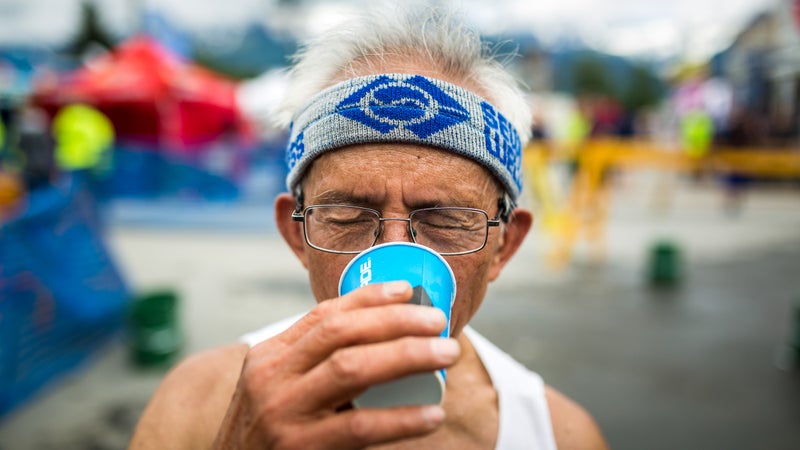
In Independence Day: Resurgence, last year’s sequel to the Fourth of July alien-invasion classic, the young space pilots have a running joke about a “controlled dive”—in other words, a plummeting potential crash. The descent from Mount Marathon is a sort of controlled dive: a hectic sliding rush along loose, soft rock that drops runners back down to the halfway point in seconds, and then sends them into a long, narrow, gravel chute that bypasses the greasy forest trails entirely, carrying them nearly to the bottom. It’s part running, part skiing, part falling, and it often leaves finishers dripping blood or with gravel shrapnel embedded in their butts and legs. The fastest racers reverse all 3,022 feet of hard-earned elevation gain and the last half-mile of pavement to the finish line in just under 11 minutes.
After being pushed hard by her competitor all the way up, Ostrander left the more cautious Arritola behind on the downhill. Ostrander never wears a watch when she races—“I really just like to focus on how I feel,” she says—so she didn’t know that she was only 41 seconds behind Forsberg’s 2015 uphill pace. Her goal for this race wasn’t to beat that record, which she felt was beyond her. Ostrander just hoped to finish under 50 minutes, something that, in the women’s race, only Forsberg had ever done. If she was going to make that, she had 13 minutes to get down the mountain and over the finish line.
The shale was loose and deep, softened by the recent hard rains. It made for a fast descent. “Almost too fast,” Ostrander said later. “My legs were just so toasted after the uphill. I think at times my legs just couldn’t really handle it.” She belly-flopped once, then twice, on her way down, tumbling face first into the heaped gravel. But she popped up quickly each time.
Then she reached Mount Marathon’s final challenge, the area known to racers as “the gut.” This is where the gravel chute narrows abruptly and becomes a running creek strewn with wet boulders and small waterfalls. Racers scramble down through the creek bed until they reach their final choice: the waterfall, the switchbacks, the cliffs, or the jeep trail.
The waterfall is a long drop (posted signage lists it as a triple-black-diamond option), and volunteers posted at the top of it will only permit racers to go over if they provide clear verbal confirmation that they’ve made that choice. The switchbacks offer a way down to the runner’s right of the waterfall, but they’re a slick nightmare in wet, muddy conditions. Then there are the cliffs—that’s where the racers came up to begin with, making their choice between roots and rock. The last option, the jeep trail, is a wide, circuitous path, totally safe but so slow that no serious contender would ever bother with it. (“There’s no shame in the jeep trail,” the race official who ran the safety meeting repeated, over and over.)
Ostrander chose the cliffs, then made her way down the last of the gravel trail and out to the road, past lines of cheering fans, a police car rolling slowly ahead of her to clear the busy streets. She hit the pavement and straightened up for the final half-mile, taking long, smooth strides. Ostrander crossed the finish line at 49:19, missing Forsberg’s record by 91 seconds but taking more than a minute off her personal best and becoming just the second woman ever to record a sub-50-minute finish.
At the line, Ostrander raised her arms above her head, then doubled over and was helped away, her legs and belly covered in the gray mud and grit she’d carried with her off the mountain.
Eva Holland (@evaholland) is a correspondent for Outside. She wrote about the Horseshoe Hell climbing competition in April 2017.
